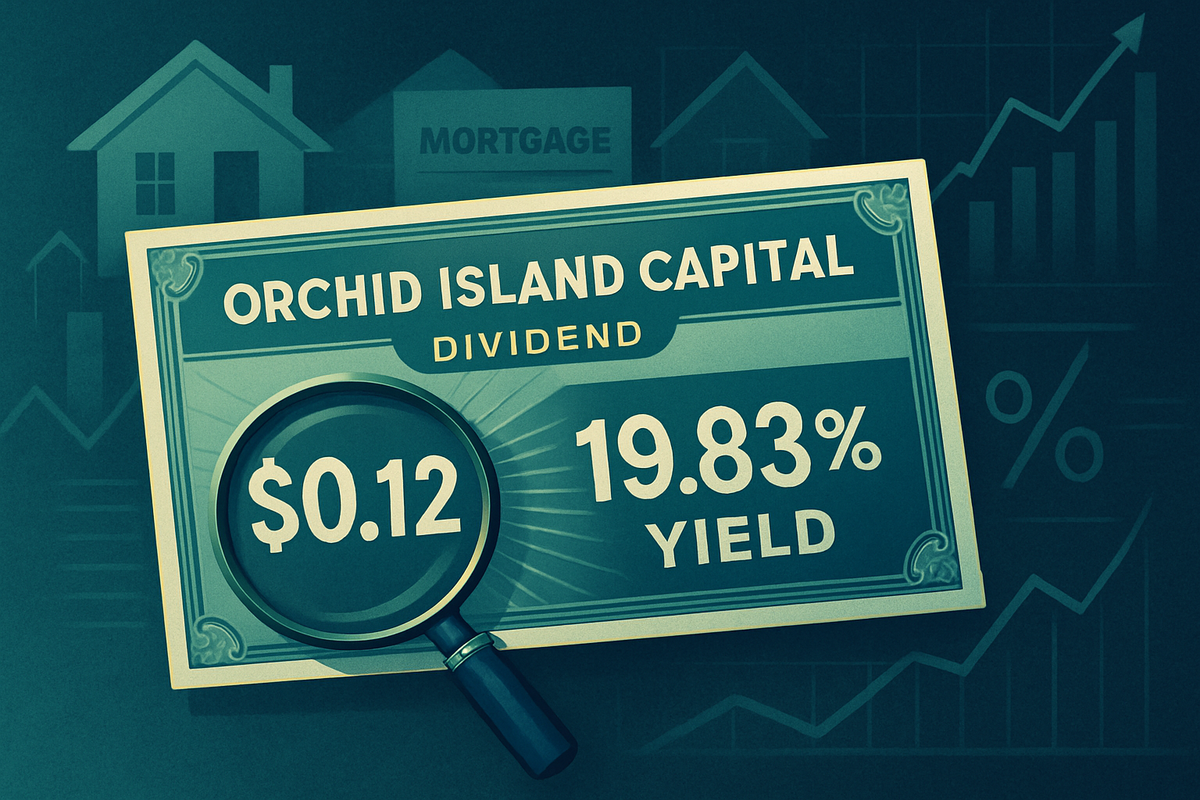
Vero Beach, FL – October 15, 2025 – Orchid Island Capital (NYSE: ORC), a prominent player in the mortgage real estate investment trust (mREIT) sector, has announced a monthly cash dividend of $0.12 per common share for October 2025. This declaration, made today, positions the company with an impressive forward dividend yield nearing 19.83% based on its recent closing price of $7.26 per share. The announcement is a crucial piece of news for income-focused investors, reinforcing the mREIT's commitment to returning capital to shareholders amidst a dynamic financial landscape.
The high yield immediately captures the attention of investors seeking substantial income streams, a characteristic often associated with the mREIT industry. However, the context of such a high yield, particularly for a company operating in a sector sensitive to interest rate fluctuations, invites closer scrutiny into the sustainability and underlying financial health of the trust. This latest dividend declaration comes as the broader market grapples with evolving interest rate policies and economic forecasts, making ORC's consistent payout a focal point for market observers.
Detailed Coverage: A Closer Look at ORC's Dividend Strategy
Orchid Island Capital (NYSE: ORC) confirmed that the $0.12 per share monthly dividend will be paid on November 26, 2025, to shareholders of record as of October 31, 2025. Investors wishing to receive this dividend must purchase shares before the ex-dividend date, also set for October 31, 2025. The company's strategy revolves around investing in Agency Residential Mortgage-Backed Securities (RMBS), leveraging its portfolio to generate income primarily from the spread between interest earned on its assets and its funding costs.
This consistent monthly dividend payout underscores ORC's operational model as a mREIT, which mandates distributing a significant portion of its taxable income to shareholders to maintain its favorable tax status. The current declaration maintains the dividend at the previously established rate, offering a degree of predictability for its investor base. While the immediate market reaction typically includes a slight adjustment in share price around the ex-dividend date, the primary impact is the reaffirmed appeal to income-driven investors.
However, the reported payout ratio of -248.28% for ORC, as of recent disclosures, raises significant questions regarding the long-term sustainability of the dividend from an earnings perspective. While mREITs often use taxable income rather than GAAP earnings to determine dividends, such a negative payout ratio indicates that the dividend is not currently covered by reported earnings, which can be a red flag for cautious investors. The company's estimated book value per share stood at $7.33 as of September 30, 2025, with estimated GAAP net income of $0.53 per share for Q3 2025, providing a mixed financial picture.
Company Impact: Navigating High Yields and Sustainability Concerns
For Orchid Island Capital (NYSE: ORC), the declaration of a $0.12 monthly dividend with an approximate 19.83% forward yield serves as a double-edged sword. On one hand, it significantly enhances the company's attractiveness to a specific segment of the investment community: those prioritizing high-income generation. This consistent payout can help maintain investor loyalty and potentially draw new capital from individuals and institutions seeking robust dividend streams in a low-yield environment.
On the other hand, the substantial payout ratio, which suggests the dividend is not fully covered by current earnings, presents a considerable challenge to ORC's long-term financial health and dividend sustainability. While mREITs can fund dividends through various means, including realized gains and capital recycling, a persistently high or negative payout ratio relative to earnings could signal that the company might be distributing more than it generates, potentially eroding its capital base over time. This concern is amplified by ORC's history of multiple dividend cuts in recent years, with the current payout being lower than its pre-2021 levels.
Investors in ORC are therefore divided into two camps: those who embrace the high yield for immediate income and those who approach with caution, scrutinizing the underlying financials and the historical volatility of its dividend. The company's ability to effectively manage its portfolio of Agency RMBS, hedge against interest rate risks, and generate sufficient taxable income will be paramount in determining the true winners and losers in the long run. The current environment of declining interest rates offers some tailwinds through reduced borrowing costs, but also brings the risk of mortgage prepayments, which could negatively impact the value of ORC's existing assets and its future earnings potential.
Wider Significance: mREITs in a Shifting Economic Landscape
Orchid Island Capital's (NYSE: ORC) dividend declaration is not an isolated event but rather a reflection of broader trends and challenges within the mREIT industry in late 2025. The Federal Reserve has initiated an easing cycle, with a 25 basis point rate cut in September and further reductions anticipated by year-end, potentially bringing the federal funds rate to 3.50%-3.75%. This trajectory of declining short-term rates is generally favorable for mREITs, as it typically lowers their borrowing costs for financing mortgage-backed securities (MBS) portfolios.
However, this environment also introduces complexity. While lower funding costs can improve net interest spreads, a rapid decline in long-term mortgage rates could trigger a surge in mortgage prepayments. This "prepayment risk" forces mREITs to reinvest capital at lower prevailing yields, potentially compressing future earnings and challenging dividend sustainability. The U.S. economy is largely expected to achieve a "soft landing," with moderating rates and robust growth, yet inflation remains a watchpoint, and geopolitical events could introduce volatility.
Historically, mREITs have been known for their high dividend yields, attracting income-seeking investors. However, their sensitivity to interest rate movements and credit markets means these dividends can be volatile. ORC's current dividend, while attractive, fits into this historical pattern of high reward accompanied by elevated risk. The industry as a whole is focused on robust hedging strategies, maintaining strong liquidity, and some firms are diversifying beyond traditional Agency MBS into areas like mortgage servicing rights (MSRs) to mitigate risks. ORC's reliance on Agency RMBS makes it particularly susceptible to the nuances of interest rate changes and prepayment speeds, underscoring the need for vigilant portfolio management in this evolving landscape.
What Comes Next: Navigating Future Market Dynamics
Looking ahead, the immediate future for Orchid Island Capital (NYSE: ORC) and its investors will largely hinge on the Federal Reserve's continued interest rate policy and the broader economic trajectory. In the short term, investors will closely monitor ORC's ability to maintain its current dividend payout, especially given its high payout ratio relative to earnings. The ex-dividend date on October 31, 2025, and the payment date on November 26, 2025, are key near-term milestones.
In the long term, ORC will need to strategically adapt its portfolio management to the anticipated environment of declining, yet potentially volatile, interest rates. While lower borrowing costs could benefit net interest margins, the persistent threat of prepayment risk requires sophisticated hedging strategies to protect against portfolio erosion and the need to reinvest at lower yields. The company's ability to manage its book value, which declined to an estimated $7.33 per share as of September 30, 2025, will be a critical indicator of its financial health.
Potential strategic pivots for ORC might include refining its hedging instruments, optimizing its leverage, and potentially exploring slight diversifications within its Agency RMBS mandate to enhance stability. Market opportunities could emerge if the spread between short-term borrowing costs and long-term mortgage yields widens favorably, allowing for improved profitability. Conversely, challenges will arise from unexpected shifts in interest rates, increased market volatility, or a more pronounced wave of prepayments. Investors should prepare for potential scenarios ranging from continued, albeit precarious, dividend stability to further adjustments if market conditions or ORC's financial performance necessitate it.
Wrap-up: A High-Yield Proposition with Inherent Volatility
Orchid Island Capital's (NYSE: ORC) declaration of a $0.12 monthly dividend, translating to a forward yield of nearly 19.83%, stands as a testament to the mREIT sector's capacity for significant income generation. This announcement, made on October 15, 2025, provides immediate clarity for income-focused investors, signaling a continued commitment to shareholder returns.
However, a comprehensive assessment reveals that this attractive yield is accompanied by inherent volatility and sustainability concerns, particularly highlighted by the company's high payout ratio and historical dividend adjustments. As the market moves forward into an environment of anticipated interest rate easing, ORC, like its mREIT peers, will navigate a complex landscape of potentially improved net interest spreads balanced against the omnipresent risk of mortgage prepayments.
Investors should watch closely for ORC's upcoming earnings reports, its management of hedging strategies, and any shifts in its book value per share. The broader economic outlook, including inflation trends and the Federal Reserve's subsequent rate decisions, will also play a pivotal role in shaping the operating environment for mREITs. While the allure of a nearly 20% yield is undeniable, a prudent investment approach demands a thorough understanding of the underlying risks and the dynamic market forces at play.
This content is intended for informational purposes only and is not financial advice

















